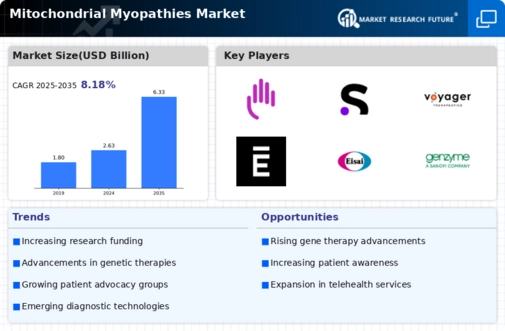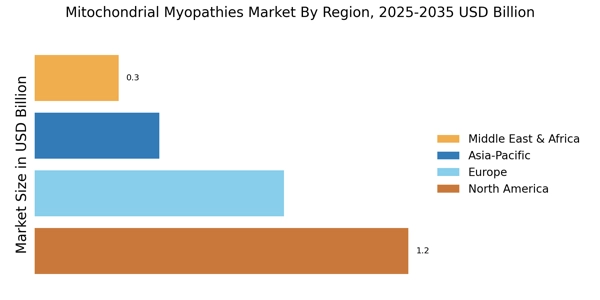Advancements in Genetic Research
Recent advancements in genetic research are significantly influencing the Mitochondrial Myopathies Market. The identification of specific genetic mutations associated with mitochondrial disorders has opened new avenues for targeted therapies. For instance, the discovery of mutations in genes such as MT-TL1 and MT-ATP6 has led to the development of gene therapies that may offer potential cures. Moreover, the integration of next-generation sequencing technologies has enhanced the ability to diagnose these conditions more accurately and swiftly. This progress not only facilitates earlier intervention but also encourages pharmaceutical companies to invest in research and development of innovative treatments. As a result, the Mitochondrial Myopathies Market is likely to experience growth driven by the increasing availability of advanced genetic testing and novel therapeutic options.
Increased Awareness and Advocacy
The Mitochondrial Myopathies Market is experiencing growth due to heightened awareness and advocacy efforts surrounding mitochondrial disorders. Patient advocacy groups and non-profit organizations are playing a vital role in educating the public and healthcare professionals about these conditions. Their initiatives often lead to improved diagnosis rates and increased funding for research. Furthermore, awareness campaigns are instrumental in promoting the importance of early detection and intervention, which can significantly impact patient outcomes. As more individuals become informed about mitochondrial myopathies, the demand for diagnostic tools and treatment options is likely to rise. This growing awareness is expected to create a more favorable environment for the Mitochondrial Myopathies Market, ultimately benefiting patients and stakeholders alike.
Growing Investment in Rare Disease Research
The Mitochondrial Myopathies Market is benefiting from a surge in investment directed towards rare disease research. Governments and private organizations are increasingly recognizing the need for funding initiatives aimed at understanding and treating rare disorders, including mitochondrial myopathies. In recent years, funding for rare disease research has seen a notable increase, with billions allocated to support clinical trials and drug development. This financial backing is crucial for fostering innovation and accelerating the development of effective therapies. Additionally, the establishment of orphan drug designations for treatments targeting mitochondrial myopathies may incentivize pharmaceutical companies to pursue research in this area. Consequently, the Mitochondrial Myopathies Market is likely to thrive as a result of enhanced research funding and a growing focus on rare diseases.
Rising Prevalence of Mitochondrial Myopathies
The increasing incidence of mitochondrial myopathies is a pivotal driver for the Mitochondrial Myopathies Market. Recent estimates suggest that mitochondrial disorders affect approximately 1 in 4,000 individuals, indicating a substantial patient population. This rising prevalence is likely to spur demand for diagnostic and therapeutic solutions, thereby propelling market growth. As awareness of these conditions expands, healthcare providers are more frequently diagnosing mitochondrial myopathies, which may lead to an uptick in treatment options. Furthermore, the growing recognition of the genetic basis of these disorders has prompted research initiatives aimed at developing targeted therapies. Consequently, the Mitochondrial Myopathies Market is poised for expansion as stakeholders seek to address the needs of this underserved patient demographic.
Technological Innovations in Treatment Modalities
Technological innovations are reshaping the Mitochondrial Myopathies Market by introducing novel treatment modalities. Advances in biotechnology, such as gene editing and mitochondrial replacement therapy, hold promise for addressing the underlying causes of mitochondrial disorders. These cutting-edge technologies may enable the development of therapies that not only alleviate symptoms but also target the root genetic issues. Additionally, the rise of personalized medicine approaches allows for tailored treatments based on individual genetic profiles, enhancing the efficacy of interventions. As these technologies continue to evolve, they are likely to attract significant investment and interest from pharmaceutical companies. Consequently, the Mitochondrial Myopathies Market is expected to expand as innovative treatment options become available, offering hope to patients and their families.


















Leave a Comment